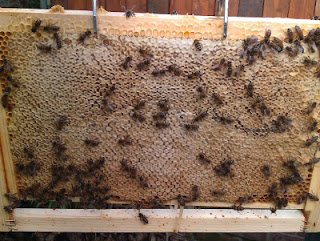As I mentioned before bees are vegetarian and get their protein from pollen but will happily recycle protein from brood if there's something wrong with it or they decide they don't need it -such as drone brood late in the year. I've also noticed a few bits of bee shell picked clean in the hives where a bee got trapped when I closed up, so I suspect they sometimes recycle each other too. So yes, whilst honeybees are vegetarian, they will eat their babies and their dead.
 |
| Bees eating pulled drone larva |
On the last hive inspection I pulled out some drone larva to check them for varroa. Didn't find any mites at all (yay!) and then dropped the now dying larva back into the hive for the bees. There was one still on the capping fork so before popping the roof on I dropped it onto the crownboard and within a few seconds the bees were on it and tucking in.
Something else I thought the bees might like to recycle is their old beeswax and propolis. Going by the forums opinion is split as to whether or not bees will reuse old wax -although within the brood frames they'll tear down existing worker comb to make drone comb when they need it. Originally I tried leaving the lumps of cut out wax onto the crownboard for them to reach, it seemed to work but did tend to get welded to the board so I decided on another approach. Now I take the cut out burr comb and any scrapings, pop it in a box and freeze it, then rattle it like hell to smash up the now brittle wax, propolis and honey into really tiny pieces. I pop these into a margarine tub with tha hole in the side and stick that on the crownboard where they can reach it.
 |
| Bees reusing old wax and propolis |
As you can see this seems to be working. I didn't do a before and after picture but when I dropped the box in you couldn't see any of the white floor of the box at all. The big lump you can see will be going back into the freezer with this weeks scrapings for breaking up another day, but the really small flakes of wax and propolis are being used
Whilst both hives are the same breed of bee I've noticed both have very different characteristics, if one were to anthopomorphisize you could say they have their own personalities. For example the bees in Hive2 seem more placid than those in Hive1. During an inspection the bees in Hive1 tend to congregate on top of the frames whereas those in Hive2 don't so much. I've also noticed that the bees in Hive2 are very quick when it comes to drawing new comb from foundation in new frames whereas those in Hive1 are a lot slower to do this but are much keener to propolise everything. Another difference seems to be that the colony in Hive1 are quite enthusiastic about reusing the old wax given to them, as in the picture above, but those of Hive2 aren't so interested.



















